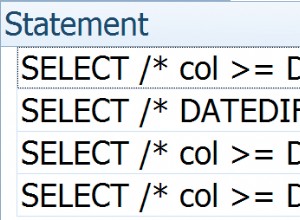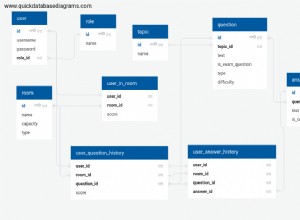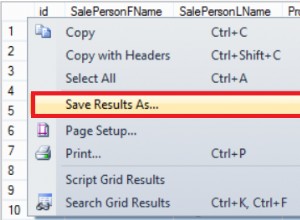with a as (
select a.*, row_number() over (partition by department order by attributeID) rn
from attributes a),
e as (
select employeeId, department, attribute1, 1 rn from employees union all
select employeeId, department, attribute2, 2 rn from employees union all
select employeeId, department, attribute3, 3 rn from employees
)
select e.employeeId, a.attributeid, e.department, a.attribute, a.meaning,
e.attribute1 as value
from e join a on a.department=e.department and a.rn=e.rn
order by e.employeeId, a.attributeid
Dados de teste e saída:
create table employees (employeeID number(3), name varchar2(10), department varchar2(5), age number(3), attribute1 varchar2(10), attribute2 varchar2(10), attribute3 varchar2(10));
insert into employees values (1, 'john', 'IT', 22, 'attr1val1', 'attr2val2', null);
insert into employees values (2, 'jane', 'HR', 32, 'attr1val3', 'attr2val4', 'attr3val5');
insert into employees values (3, 'joe', 'HR', 23, 'attr1val6', 'attr2val7', 'attr3val8');
insert into employees values (4, 'jack', 'IT', 45, 'attr1val9', 'attr2val10', null);
create table attributes (attributeID number(3), department varchar2(10), attribute varchar2(10), meaning varchar2(10));
insert into attributes values (1, 'IT', 'attribute1', 'laptoptype');
insert into attributes values (2, 'IT', 'attribute2', 'networkloc');
insert into attributes values (3, 'HR', 'attribute1', 'location');
insert into attributes values (4, 'HR', 'attribute2', 'position');
insert into attributes values (5, 'HR', 'attribute3', 'allocation');
EMPLOYEEID ATTRIBUTEID DEPARTMENT ATTRIBUTE MEANING VALUE
---------- ----------- ---------- ---------- ---------- ----------
1 1 IT attribute1 laptoptype attr1val1
1 2 IT attribute2 networkloc attr2val2
2 3 HR attribute1 location attr1val3
2 4 HR attribute2 position attr2val4
2 5 HR attribute3 allocation attr3val5
3 3 HR attribute1 location attr1val6
3 4 HR attribute2 position attr2val7
3 5 HR attribute3 allocation attr3val8
4 1 IT attribute1 laptoptype attr1val9
4 2 IT attribute2 networkloc attr2val10
Editar :Explicação
Em resposta, usei
with
cláusula apenas para dividir a solução em etapas legíveis. Você pode movê-los para from cláusula da consulta principal se for mais confortável para você. De qualquer forma:subconsulta a lê dados da tabela attributes e adiciona o número das linhas, portanto, para cada departamento, elas são sempre numeradas a partir de 1. Usei número_linha()
por isso. Subconsulta e uniões (todos) os atributos necessários e os numera de acordo. Os números gerados em ambas as subconsultas são então usados na junção principal:a.department=e.department and a.rn=e.rn . Alternativa 1 - se você estiver usando o Oracle 11g, poderá usar o unpivot . Veja o que é gerado pela subconsulta e como ela é unida aos
attributes tabela:with e as (
select employeeId, name, department, attribute, value from employees
unpivot (value for attribute in ("ATTRIBUTE1", "ATTRIBUTE2", "ATTRIBUTE3"))
)
select e.employeeId, a.attributeid, e.department, a.attribute,
a.meaning, e.value
from e join attributes a on a.department=e.department
and lower(a.attribute)=lower(e.attribute)
order by e.employeeId, a.attributeid;
Alternativa 2 - com gerador de subconsulta hierárquica (subconsulta
r ), realizado por connect by
que simples cria números de 1, 2, 3 que são unidos em seguida com employees e o atributo apropriado é anexado como valor em case cláusula. O descanso é feito de maneira semelhante à resposta original. with a as (
select a.*, row_number() over (partition by department order by attributeID) rn
from attributes a),
r as (select level rn from dual connect by level<=3),
e as (
select employeeId, department, rn,
case when r.rn = 1 then attribute1
when r.rn = 2 then attribute2
when r.rn = 3 then attribute3
end value
from employees cross join r
)
select e.employeeId, a.attributeid, e.department, a.attribute,
a.meaning, e.value
from e join a on a.department=e.department and a.rn=e.rn
order by e.employeeId, a.attributeid
Todas as três versões me deram a mesma saída. Também testei a primeira opção em uma tabela semelhante com 100 mil linhas e obtive saída em poucos segundos (para 5 atributos). Por favor, teste todas as soluções e tente entendê-las. Se você pode usar a versão unpivot eu preferiria this.Sorry para explicação atrasada e quaisquer erros de linguagem.




